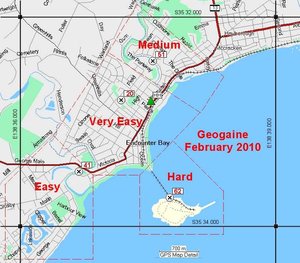Difference between revisions of "Geogaine"
From GeoWiki
| Line 1: | Line 1: | ||
| + | [[Image:Geogaine2010PlayerMap.jpg|thumb|right|frameless|300px|The initial map for the players]] | ||
A geogaine event is the combination of [http://rogaine.asn.au/What-is-Rogaining-/ rogaining] and geocaching. The aim is to find a maximum number of special temporary geocaches in a fixed period of time on foot. | A geogaine event is the combination of [http://rogaine.asn.au/What-is-Rogaining-/ rogaining] and geocaching. The aim is to find a maximum number of special temporary geocaches in a fixed period of time on foot. | ||
Unlike traditional rogaines where the navigation tools are maps and compasses and the controls are clearly visible, geogaining allows the use of a GPS unit and the controls are hidden like typical geocaches. Apart from these differences geogaines share the same set of [http://rogaine.asn.au/Rules-and-Standards/rules.html#rules rules] with rogaining with the exception of rules R3,R7 and R19. | Unlike traditional rogaines where the navigation tools are maps and compasses and the controls are clearly visible, geogaining allows the use of a GPS unit and the controls are hidden like typical geocaches. Apart from these differences geogaines share the same set of [http://rogaine.asn.au/Rules-and-Standards/rules.html#rules rules] with rogaining with the exception of rules R3,R7 and R19. | ||
Revision as of 18:25, 15 July 2010
A geogaine event is the combination of rogaining and geocaching. The aim is to find a maximum number of special temporary geocaches in a fixed period of time on foot. Unlike traditional rogaines where the navigation tools are maps and compasses and the controls are clearly visible, geogaining allows the use of a GPS unit and the controls are hidden like typical geocaches. Apart from these differences geogaines share the same set of rules with rogaining with the exception of rules R3,R7 and R19. The main unique aspects of a geogaine are:
Contents
Playing Area
- The playing area has 4 zones on it with one entry geogaine cache in each zone.
- The cache hides in each zone are rated by a combined terrain & difficulty rating.
- The ratings are Very Easy, Easy, Medium and Hard.
- Generally the more difficult a zone, the more points each cache is worth.
- The total points value for each zone is listed with the entry caches.
Cache types
- Entry caches have a unique stamp for players to record their visit and coordinates for other standard caches in that zone.
- Standard caches contain a unique stamp to be used to stamp the control card.
- Both types of caches will generally be hidden and/or camouflaged.
- Both types of caches have points associated with them.
- At the start of the game the competitors are given the coordinates of the 4 entry caches in printed format.
Maps
- At this stage it is planned to have a map showing the Hash House, 4 zones and 4 entry caches.
Scoring
- Each cache found is worth between 10 and 90 points.
- Teams must return to the Hash House within the allocated time or be penalised by 10 points for each minute late.
- In the event of tied points totals the earliest team back is placed higher.
The first Geogaine set was Geogaine 2010 at Victor Harbor, South Australia.
